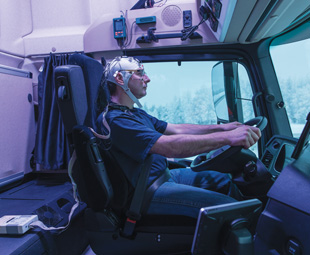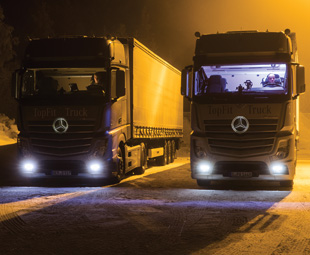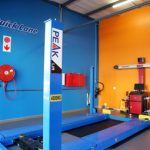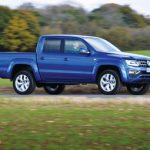Let there be light!

What difference does light make to a truck driver – if any? CHARLEEN CLARKE reports on an utterly fascinating research project that recently took place in Finland
Have you driven on the N3 or N1 at night recently? If so, you will have noticed something: a steady stream of lights, many emanating from trucks. As we all know, a truck driver’s job is not a 08:00 to 17:00 gig; many drivers spend endless hours behind the wheel at night. (Some would argue too many…)
As such, the lighting in a truck can truly impact on the driver. After all, the cab is his office. How would you like to sit in an office with terrible lighting?
Lighting is, in fact, probably one of the least appreciated – but most needed – aspects of life. We don’t give a great deal of thought to it – provided we aren’t actually suffering from a lack of light. And yet light dictates how life on earth is organised.
Among other factors, the shift from day to night and back again provides structure as a short-term time cycle, as do the changing seasons. As humans have evolved, a number of internal clocks have adapted to these circumstances and help to synchronise our circadian rhythms. What is particularly important in this context is regular switching between day and night.
 For many years, scientists have been researching the complex relationships between the availability of biologically effective light and the physical and mental states of human beings. Various related health problems have been defined. One of the most common is seasonal affective disorder (commonly referred to as SAD).
For many years, scientists have been researching the complex relationships between the availability of biologically effective light and the physical and mental states of human beings. Various related health problems have been defined. One of the most common is seasonal affective disorder (commonly referred to as SAD).
A lack of light is a serious problem for many people in the countries of Northern Europe, for example, where it barely gets light during the winter months, and this can result in poor mood, reduced performance and a lack of motivation. Light therapy is a standard method of treating these symptoms medically and combating them successfully.
With this as a background, a research team recently ventured to Finland and simulated two typical working weeks for truckers in Rovaniemi’s polar light. Once there, the truckers alternated between driving for one week in a truck cab with conventional lighting and for another week in a cab with a Daylight+ module that provides additional daylight while driving and during breaks.
Siegfried Rothe, from the Daimler’s research department, headed the project, and he tells FOCUS that he had a clear working hypothesis: that an application of biologically effective light with a wavelength of between 460 and 490 nanometres has positive effects. “As such, we designed a sophisticated series of experiments to test this hypothesis,” he explains.
The idea for Daylight+ arose during the course of a series of experiments at the sleep lab at the University of Regensburg. Rothe is involved in numerous projects to help improve working and living conditions for truck drivers and thereby improve the image of this occupation.
He subsequently determined that, due primarily to the outline shape of a conventional truck cab, only a comparatively low percentage of natural daylight reaches the driver’s light receptors.
 “This finding prompted me to think about potential solutions. The results of an initial series of experiments with engineers from the test drive department were unambiguous. The subjective condition of all test subjects improved significantly under the influence of an additional dose of light, regardless of the time of day. Another finding proved surprising: the test found that drivers with more daylight in the cab drove more economically,” Rothe reveals.
“This finding prompted me to think about potential solutions. The results of an initial series of experiments with engineers from the test drive department were unambiguous. The subjective condition of all test subjects improved significantly under the influence of an additional dose of light, regardless of the time of day. Another finding proved surprising: the test found that drivers with more daylight in the cab drove more economically,” Rothe reveals.
During the experiments in Rovaniemi, the test subjects were only ever compared against themselves. The experiments examined how a driver’s performance changes when he or she is exposed to additional biologically effective daylight under clearly defined conditions. The extra dose of light took three forms involving different intensities:
• Steady light while driving, whereby the intensity was adjusted to the exterior light level.
• An intense light shower of maximum intensity during the tests before and after driving.
• Light while reclined, likewise of maximum intensity, during breaks while the driver relaxes in his or her seat, which has been positioned for a power nap.
During the night, the test subjects slept in a normally darkened truck. For the test drivers, these experiments in the Arctic Circle were a tough test of their capabilities.
The team documented the test results with support from co-researcher Dr Michael Schrauf and the use of electroencephalography (EEG), electrocardiography (ECG) and electrooculography (EOG) and other physiological measurements, as well as saliva samples (to ascertain levels of the sleep hormone melatonin).
 Mental state and professional performance, which are closely related, were examined using standardised psychological test procedures (sustained attention and reaction tests on the computer) and by recording vehicle data through the FleetBoard telematics system.
Mental state and professional performance, which are closely related, were examined using standardised psychological test procedures (sustained attention and reaction tests on the computer) and by recording vehicle data through the FleetBoard telematics system.
At the end of the two-week cycles, the individual drivers were interviewed, having previously recorded their subjective impressions.
Richard Schneider and Philippe Strasser (two truck test drivers for Daimler) spent time in the Arctic Circle at the darkest time of the year, just before the winter solstice. Both of them separately expressed enthusiasm for Daylight+. The drivers consistently reported that they perceived the space inside the cab to be considerably more pleasant with the additional light fitting.
“When designing the series of tests, we hadn’t even considered that the space might appear larger,” admits Rothe. Now that the actual experiment is over, the real work is starting – Rother estimates that it will take several months to sift through all data from the experiments conducted in the Arctic Circle.
“Only then we will be able to make a recommendation as to whether the test findings should advisably lead to changes in the design of cab lighting,” he tells FOCUS.
One thing is certain, though: the findings should certainly shed some light on the matter… (Sorry, we just couldn’t resist that.)
Published by
Focus on Transport
focusmagsa




